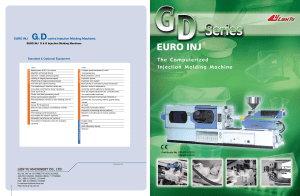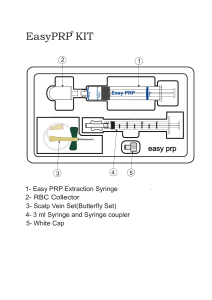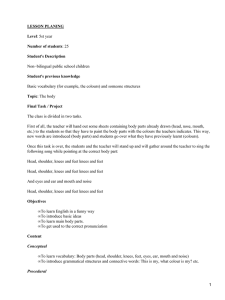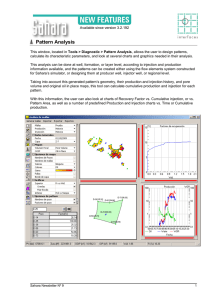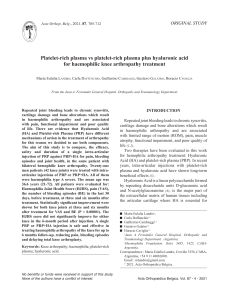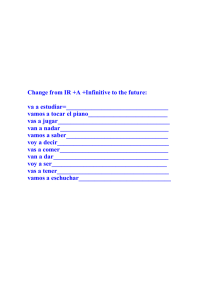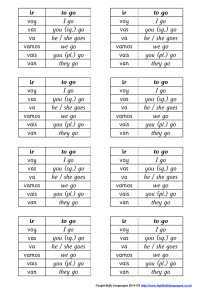Comparison of the effectiveness of platelet-rich plasma, corticosteroid, and physical therapy in subacromial impingement syndrome
Anuncio
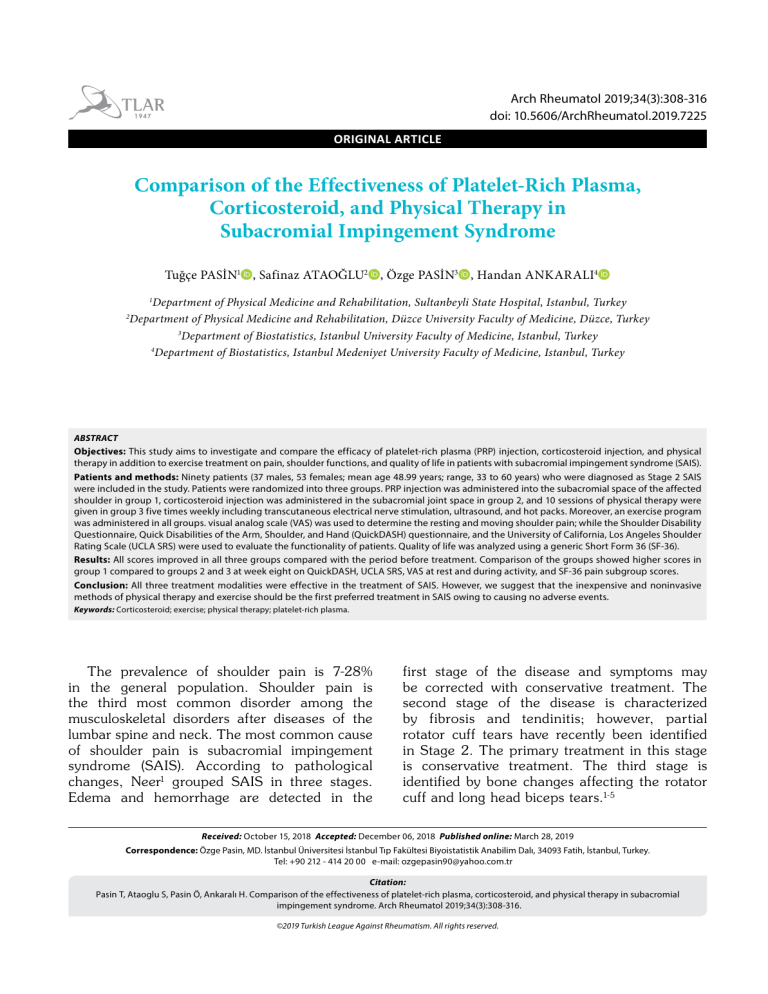
Arch Rheumatol 2019;34(3):308-316 doi: 10.5606/ArchRheumatol.2019.7225 ORIGINAL ARTICLE Comparison of the Effectiveness of Platelet-Rich Plasma, Corticosteroid, and Physical Therapy in Subacromial Impingement Syndrome Tuğçe PASİN1 , Safinaz ATAOĞLU2 , Özge PASİN3 , Handan ANKARALI4 Department of Physical Medicine and Rehabilitation, Sultanbeyli State Hospital, Istanbul, Turkey Department of Physical Medicine and Rehabilitation, Düzce University Faculty of Medicine, Düzce, Turkey 3 Department of Biostatistics, Istanbul University Faculty of Medicine, Istanbul, Turkey 4 Department of Biostatistics, Istanbul Medeniyet University Faculty of Medicine, Istanbul, Turkey 1 2 ABSTRACT Objectives: This study aims to investigate and compare the efficacy of platelet-rich plasma (PRP) injection, corticosteroid injection, and physical therapy in addition to exercise treatment on pain, shoulder functions, and quality of life in patients with subacromial impingement syndrome (SAIS). Patients and methods: Ninety patients (37 males, 53 females; mean age 48.99 years; range, 33 to 60 years) who were diagnosed as Stage 2 SAIS were included in the study. Patients were randomized into three groups. PRP injection was administered into the subacromial space of the affected shoulder in group 1, corticosteroid injection was administered in the subacromial joint space in group 2, and 10 sessions of physical therapy were given in group 3 five times weekly including transcutaneous electrical nerve stimulation, ultrasound, and hot packs. Moreover, an exercise program was administered in all groups. visual analog scale (VAS) was used to determine the resting and moving shoulder pain; while the Shoulder Disability Questionnaire, Quick Disabilities of the Arm, Shoulder, and Hand (QuickDASH) questionnaire, and the University of California, Los Angeles Shoulder Rating Scale (UCLA SRS) were used to evaluate the functionality of patients. Quality of life was analyzed using a generic Short Form 36 (SF-36). Results: All scores improved in all three groups compared with the period before treatment. Comparison of the groups showed higher scores in group 1 compared to groups 2 and 3 at week eight on QuickDASH, UCLA SRS, VAS at rest and during activity, and SF-36 pain subgroup scores. Conclusion: All three treatment modalities were effective in the treatment of SAIS. However, we suggest that the inexpensive and noninvasive methods of physical therapy and exercise should be the first preferred treatment in SAIS owing to causing no adverse events. Keywords: Corticosteroid; exercise; physical therapy; platelet-rich plasma. The prevalence of shoulder pain is 7-28% in the general population. Shoulder pain is the third most common disorder among the musculoskeletal disorders after diseases of the lumbar spine and neck. The most common cause of shoulder pain is subacromial impingement syndrome (SAIS). According to pathological changes, Neer1 grouped SAIS in three stages. Edema and hemorrhage are detected in the first stage of the disease and symptoms may be corrected with conservative treatment. The second stage of the disease is characterized by fibrosis and tendinitis; however, partial rotator cuff tears have recently been identified in Stage 2. The primary treatment in this stage is conservative treatment. The third stage is identified by bone changes affecting the rotator cuff and long head biceps tears.1-5 Received: October 15, 2018 Accepted: December 06, 2018 Published online: March 28, 2019 Correspondence: Özge Pasin, MD. İstanbul Üniversitesi İstanbul Tıp Fakültesi Biyoistatistik Anabilim Dalı, 34093 Fatih, İstanbul, Turkey. Tel: +90 212 - 414 20 00 e-mail: [email protected] Citation: Pasin T, Ataoglu S, Pasin Ö, Ankaralı H. Comparison of the effectiveness of platelet-rich plasma, corticosteroid, and physical therapy in subacromial impingement syndrome. Arch Rheumatol 2019;34(3):308-316. ©2019 Turkish League Against Rheumatism. All rights reserved. Comparison of Treatments in Subacromial Impingement Syndrome The purpose of treatment in SAIS is to stop the inflammatory process, reduce pain, prevent progressive degenerative changes, provide improved joint range of motion, increase muscle strength, and organize the daily life activities. In the literature, the limits of conservative and surgical treatments are indefinite, while primary treatment is conservative.6,7 Platelet-rich plasma (PRP) contains many growth factors such as transforming growth factor, fibroblast growth factor, vascular endothelial growth factor, insulin-like growth factor, thrombocyte-derived angiogenic factor, epithelial growth factor, platelet-derived growth factor, and platelet activating factor-4.8 The interest in PRP has increased due to its inclusion of growth factors.9-11 Local corticosteroid injections have frequently been used particularly in the first and second stages of disease, and found to have no longterm effect while half of the patients reported repeated symptoms.12 In addition, corticosteroids have adverse effects such as atrophy, systemic absorption, infection, subcutaneous tendon rupture, and tendon rupture on the skin.13 Physical therapy has an effective role in the treatment of SAIS. The single or combined use of physical therapy agents and exercise are effective in treatment. Studies have shown that physical therapy and exercise have therapeutic effects for patients diagnosed with SAIS.14-16 Therefore, in this study, we aimed to investigate and compare the efficacy of PRP injection, corticosteroid injection, and physical therapy in addition to exercise treatment on pain, shoulder functions, and quality of life in patients with SAIS. PATIENTS AND METHODS The study was conducted at Düzce University Medical Faculty between September 2015 and September 2016 and included patients who presented with symptoms of shoulder pain at least for three months without major trauma. Patients with other types of shoulder pain due to cervical radiculopathy, thoracic outlet syndrome, dermatologic disease involving the shoulder, neuromuscular disease with muscle weakness, inflammatory joint disease, infection, metallic 309 implants in the shoulder, cardiovascular disease, history of malignancy, diabetes mellitus or other endocrine system diseases, pregnancy, shoulder, back or neck operations, or those who were cardiac pacemaker carriers using nonsteroidal antiinflammatory drugs in the last week were excluded. Detailed physical examinations were performed. Manual muscle strength and speed test, Hawkins test, Neer compression test, Jobe test, painful arch test, and Yergason's test results were evaluated, and the shoulder joint range of motion was also evaluated using a standardized goniometer. Routine blood tests including erythrocyte sedimentation rate, complete blood count, C-reactive protein, and rheumatoid factor were studied after detailed anamnesis and physical examination. Posteroanterior chest radiography, four-way cervical radiography, shoulder radiography for both shoulders, and magnetic resonance imaging (MRI) for the affected shoulder were performed. The study protocol was approved by the Düzce University Medical Faculty Ethics Committee. A written informed consent was obtained from each patient. The study was conducted in accordance with the principles of the Declaration of Helsinki. Diagnosis of SAIS was established in accordance with the clinical and MRI information of the patients. Patients with Stage 1 and 3 SAIS were excluded. Ninety patients (37 males, 53 females; mean age 48.99 years; range, 33 to 60 years) diagnosed with fibrosis, tendinitis, and Stage 2 SAIS were included in the study. Visual analog scale (VAS) scores were measured at rest and during activity to detect the severity of pain, while shoulder functions were assessed using the Shoulder Disability Questionnaire (SDQ), Quick Disabilities of the Arm, Shoulder and Hand (QuickDASH) questionnaire, and the University of California, Los Angeles Shoulder Rating Scale (UCLA SRS). Short Form 36 (SF-36) was used to evaluate the quality of life. Measurements were performed at weeks three and eight after treatment. The same blinded investigator performed all evaluations. Approximately 100 patients were expected to visit the policlinic with SAIS during the six month data collection period. The minimum required sampling size was calculated. Based on statistical calculations, it was decided to include at least 30 patients in each group. These patients were 310 Arch Rheumatol divided into groups homogeneously based on their demographic characteristics with a balanced distribution. Subacromial PRP injection and exercise were administered in group 1 (n=30), subacromial corticosteroid injection and exercise were administered in group 2 (n=30), and physical therapy including hot packs, transcutaneous electrical nerve stimulation (TENS), and ultrasound as well as exercise were administered in group 3 (n=30). Shoulder rotation movements and overhead and back activities which might cause pain were avoided for the first two days before the initiation of the treatment. Patients were allowed to use paracetamol and cold application if needed. Nonsteroidal anti-inflammatory drugs were not used due to risk of reducing the effect of PRP. Two days later, patients were taken to a three-week exercise program. The exercise program started with joint range of motion, Codman’s exercises, posterior joint capsule, and stretching exercises including the pectoral muscles. Isometric strengthening exercises were included at the end of week two. Exercise protocol was performed for eight weeks by teaching the standard stretching and isotonic strengthening exercises. Neotec Biotechnology PRP kit (Neotec Biotechnology Ltd., Istanbul, Turkey) and Elektromag device model 415P (Elektro-Mag A ., Istanbul, Turkey) were used for the PRP injection. Totally 8.5 mL cubital blood was drawn for the PRP method and 1.5 mL citrate was included to prevent clotting. A total of 10 mL anticoagulated blood was centrifuged at 1200 G for five minutes by placing in a specially designed tube. After the first centrifugation, the poor plasma was withdrawn by an injector from the tube and was discarded. The tube was centrifuged a second time for 10 minutes at 1200 G to obtain 4 mL of PRP. No buffering or activating agent was used for PRP. The resulting 4 mL PRP was injected into the subacromial space. A single dose of 40 mg/mL triamcinolone acetonide and 3 mL lidocaine 2% were administered to the subacromial area with steroid injection. Physical therapy and superficial heating agents, namely hot packs, were applied for 10 sessions to the painful shoulder for 20 minutes. For Transcutaneous Electrical Nerve Stimulation (TENS), BTL-4000 combined therapy device (BTL India Pvt. Ltd., New Delhi, India) was used in conventional method for 20 minutes with four electrodes and in transarticular method for 10 sessions five times weekly. Ultrasonic deep heating was applied at a dose of 1.5 watts/cm2, at 1 MHz frequency for eight to 10 sessions per week in continuous and circular mode. Table 1. Periodic changes in VAS scores during activity Group Mean±SD p Differences before treatment and at week 3 after treatment Platelet-rich plasma injection 3.5±1.1 Corticosteroid injection 3.7±1.6 Physical therapy 4.1±1.1 0.112 Differences at week 3 and week 8 after treatment Platelet-rich plasma injection *2.5±1.0 Corticosteroid injection 1.4±0.8 Physical therapy †1.1±0.4 <0.001 Differences before treatment and at week 8 after treatment Platelet-rich plasma injection *6.0±0.9 Corticosteroid injection 5.1±1.5 Physical therapy †5.2±1.1 0.018 VAS: Visual analog scale; * p<0.05 and platelet-rich plasma injection versus corticosteroid injection; † p<0.05 and platelet-rich plasma injection versus physical therapy. 311 Comparison of Treatments in Subacromial Impingement Syndrome Table 2. Comparison of VAS at rest and VAS during activity with SDQ before and after treatment Group 1 PRP injection Group 2 Corticosteroid injection Group 3 Physical therapy Group comparisons Mean±SD Mean±SD Mean±SD p Before treatment 4.9±0.87 4.8±0.6 4.9±0.5 0.673 Week 3 after treatment 1.3±0.5 1.2±0.4 1.1±0.5 0.182 Week 8 after treatment 0.8±0.6 0.9±0.6 0.8±0.6 0.744 0.001 0.001 0.001 VAS at rest Repeated measures comparisons (p) VAS during activity Before treatment 8.0±0.8 7.9±0.8 8.0±0.8 0.907 Week 3 after treatment 4.5±1.2 4.2±1.4 3.9±1.0 0.100 Week 8 after treatment 2.0±0.9 2.8±1.2 2.7±0.9 0.013 0.001 0.001 0.001 Repeated measures comparisons (p) SDQ Before treatment 82.1±17.1 79.5±17.7 78.1±19.5 0.692 Week 3 after treatment 29.5±13.5 27.3±12.0 28.9±15.9 0.802 Week 8 after treatment 10.0±5.3 13.2±12.3 12.8±9.2 0.344 <0.001 <0.001 <0.001 Repeated measures comparisons (p) VAS: Visual analog scale; SDQ: Shoulder Disability Questionnaire; PRP: Platelet-rich plasma. Statistical analysis Statistical analyses were performed using the IBM SPSS version 21.0 software (IBM Corp., Armonk. NY, USA). Descriptive statistics were used for the continuous and categorical variables. Shapiro-Wilk test was used in variables with normal distribution. One-way analysis of variance (ANOVA) was used in the comparison between the means of the group. The Pearson’s chi-square and Fisher-Freeman-Halton tests were used in the evaluation of the association between the categorical variables. Repeated measures of ANOVA were conducted to test whether there was a significant change in the periods for variables with normal distribution, while Friedman’s test was used in testing the Table 3. Periodic changes in VAS scores at rest Group The mean differences Differences in standard deviation Platelet-rich plasma injection 3.63 0.999 Corticosteroid injection 3.66 0.758 Physical therapy 3.86 0.776 Platelet-rich plasma injection 0.46 0.507 Corticosteroid injection 0.23 0.430 Physical therapy 0.23 0.430 Platelet-rich plasma injection 4.1 1.093 Corticosteroid injection 3.9 0.758 Physical therapy 4.1 0.803 p Differences before treatment and at week 3 after treatment 0.591 Differences at week 3 and week 8 after treatment 0.081 Differences before treatment and at week 8 after treatment VAS: Visual analog scale. 0.505 312 Arch Rheumatol Table 4. Comparison of SDQ during activity before and after treatment Group 1 PRP injection Group 2 Corticosteroid injection Group 3 Physical therapy Group comparisons Mean±SD Mean±SD Mean±SD p Before treatment 82.1±17.1 79.5±17.7 78.1±19.5 0.692 Week 3 after treatment 29.5±13.5 27.3±12.0 28.9±15.9 0.802 Week 8 after treatment 10.0±5.3 13.2±12.3 12.8±9.2 0.344 <0.001 <0.001 <0.001 Repeated measures comparisons (p) SDQ: Shoulder Disability Questionnaire; PRP: Platelet-rich plasma. The mean ages in groups 1, 2, and 3 were 49.4±9.1 years, 47.73±9.552 years, and 49.86±9.012 years, respectively. The durations of symptoms in groups 1, 2, and 3 were 0.77±0.664 months, 0.92±1.121 months, and 1.01±1.227 months, respectively. The durations of symptoms and mean ages were similar between the groups (p>0.05). (p=0.6). After treatment, the mean VAS score significantly decreased in all groups from week three to week eight (p<0.01 for each periodic change); however, no change was detected in the amount of reduction (p=0.2 for week three and p=0.7 for week eight). The difference in VAS scores during activity between periods was statistically significant for each group (p<0.01 for all) (Table 1). The difference between periods was statistically significant for each group in terms of SDQ (p<0.01). However, there was no significant difference between the groups for each period (p=0.7, p=0.8, and p=0.3, respectively) (Table 2). Improvement in VAS scores at rest was similar in all groups after treatment (p=0.6, p=0.1, and p=0.5, respectively) (Table 3). There was no significant difference in resting VAS values between the groups before treatment The mean SDQ scores in all groups were similar before treatment (p=0.7). After difference of periods for non-normal distribution. Kruskal-Wallis test was used for differences between groups in terms of periodic changes. A 5% type I error level was used to infer statistical significance. RESULTS Table 5. Comparison for UCLA SRS and QuickDASH during activity before and after treatment Group 1 PRP injection Group 2 Corticosteroid injection Group 3 Physical therapy Group comparisons Mean±SD Mean±SD Mean±SD p UCLA SRS Before treatment 14.6±4.5 16.4±4.0 15.6±3.8 0.344 Week 3 after treatment 31.4±2.5 33.3±4.0 32.7±2.2 0.581 Week 8 after treatment *38.3±3.3 †35±3.5 †34.5±2.5 0.001 <0.001 <0.001 <0.001 Repeated measures comparisons (p) QuickDASH Before treatment 78.5±6.8 78.5±7.7 77.6±7.6 0.775 Week 3 after treatment *62.3±8.7 †58.0±6.7 †56.8±9.5 0.032 Week 8 after treatment 24.5±5.2* †28.9±7.2 †29.5±6.4 0.013 <0.001 <0.001 <0.001 Repeated measures comparisons (p) UCLA SRS: University of California, Los Angeles Shoulder Rating Scale; PRP: Platelet-rich plasma; QuickDASH: Quick Disabilities of Arm, Shoulder and Hand Score; * p<0.05 and platelet-rich plasma injection versus corticosteroid injection; † p<0.05 and platelet-rich plasma injection versus physical therapy. 313 Comparison of Treatments in Subacromial Impingement Syndrome Table 6. Comparison for SF-36 during activity before and after treatment SF-36 Sub-dimensions Period Physical function Before treatment p 0.628 74.3±15.9 0.464 Week 8 after treatment 84.5±12.8 80.7±17.8 78.5±16.2 0.442 <0.001 <0.001 <0.001 14.2±14.2 16.7±19.0 15.8±18.0 Before treatment 0.960 Week 3 after treatment 74.5±6.7 76.0±7.5 75.2±6.6 0.594 Week 8 after treatment 95.2±6.1 93.7±6.6 93.2±6.2 0.354 <0.001 <0.001 <0.001 Before treatment 29.3±12.3 27.6±9.5 30.9±14.4 Week 3 after treatment 72.8±6.0 75.2±9.4 72.4±6.0 0.087 Week 8 after treatment 81.3±9.0 *77.5±7.6 †76.3±5.5 0.050 <0.001 <0.001 <0.001 0.388 Before treatment 36.6±12.3 *34.2±11.8 †55.8±20.2 Week 3 after treatment 74.1±11.8 77.5±20.6 73.8±12.0 0.919 Week 8 after treatment 86.3±11.1 85.6±15.4 81.8±11.7 0.869 <0.001 <0.001 <0.001 Before treatment 54.9±14.7 57.2±9.3 55.9±10.4 0.852 Week 3 after treatment 72.9±8.7 71.9±7.3 70.9±4.5 0.632 Week 8 after treatment 77.3±7.3 76.4±6.1 74.9±8.3 0.687 <0.001 <0.001 <0.001 <0.001 Before treatment 40.0±33.2 37.8±36.9 40.0±36.5 0.931 Week 3 after treatment 63.3±32.0 60.0±32.0 57.8±38.1 0.858 Week 8 after treatment 71.1±21.0 67.7±22.3 66.6±26.3 0.761 <0.001 <0.001 <0.001 Before treatment 43.2±15.7 45.8±17.3 42.7±14.8 Week 3 after treatment 54.2±15.3 54±17.7 52.3±14.1 0.857 Week 8 after treatment 67.3±11.3 68.2±14.2 65.7±9.7 0.534 <0.001 <0.001 <0.001 Repeated measures comparisons (p) General health Mean±SD 59.2±25.2 Repeated measures comparisons (p) Vitality Mean±SD 62.2±27.0 Repeated measures comparisons (p) Emotional Mean±SD 75.2±21.2 Repeated measures comparisons (p) Mental health Group comparisons 72.3±15.2 Repeated measures comparisons (p) Social function Group 3 Physical therapy 58.2±20.1 Repeated measures comparisons (p) Pain Group 2 Corticosteroid injection Week 3 after treatment Repeated measures comparisons (p) Physical role Group 1 PRP injection Before treatment 0.805 22.7±9.3 20.8±10.8 20.2±6.2 0.641 Week 3 after treatment 62.5±11.9 63.3±14.3 62.3±11.2 0.775 Week 8 after treatment 81.3±6.7 79.3±6.4 78.8±7.8 0.112 <0.001 <0.001 <0.001 Repeated measures comparisons (p) SF-36: Short Form 36; PRP: Platelet-rich plasma; * p<0.05 and platelet-rich plasma injection versus corticosteroid injection; † p<0.05 and corticosteroid injection versus physical therapy. treatment, the mean SDQ scores in all groups significantly decreased until the eighth week (p<0.01). The mean SDQ scores after treatment at weeks three and eight were statistically similar between the groups (p=0.8 and p=0.3, respectively) (Table 4). There was no significant difference in the mean UCLA SRS values between the groups (p=0.3) before treatment. The mean UCLA SRS values in all groups significantly increased after treatment until week eight (p<0.01). The increased mean UCLA SRS values until week three were similar 314 Arch Rheumatol between the groups (p=0.6). However, the mean UCLA SRS value was significantly higher in group 1 at week eight compared to groups 2 and 3 (p<0.01) (Table 5). No statistically significant differences were detected between groups in the QuickDASH scores (p=0.8). The QuickDASH scores in all groups showed a significant decrease at weeks three and eight after treatment (p<0.01 for each). The mean QuickDASH score in week three in group 1 was lower compared to groups 2 and 3 (p=0.03). The decrease in week eight was significantly higher in group 1 compared to groups 2 and 3 (p=0.01). The improvement in QuickDASH scores in groups 2 and 3 was similar after treatment at weeks three and eight (p>0.05) (Table 5). In terms of SF-36 results, the mean social function sub-dimension for group 3 was significantly higher than groups 1 and 2 (p<0.01); however, the means of social function scores were similar between groups 1 and 2 before treatment (p>0.05). The mean scores of the other seven subscales were similar in all groups before treatment. After treatment, improvement was detected in all subscales of the SF-36 until week eight (p<0.01 for each). Group 1 had more improvement at week eight compared to groups 2 and 3 only regarding pain and the improvement was statistically significant (p=0.05) (Table 6). DISCUSSION The initial treatment of SAIS is conservative and the most important part of this treatment involves exercise treatment.17,18 Michener et al.4 19 have detected in 12 studies which investigated SAIS between 1966 and 2003 that patients benefitted from exercises; therefore, studies included exercise treatment. Studies comparing exercise treatment with surgical treatment have found no longterm differences between exercise and surgical treatment.18-20 Thus, we performed exercise treatment as a non-invasive and effective treatment in addition to all other treatments. Although exercises are known to be effective in treatment, no consensus has yet been reached on the treatment program to be implemented.20-22 Levendo¤lu et al.23 have randomized 52 SAIS patients into two groups and administered exercises for both groups. In addition to exercises, they have performed 15 sessions of physical therapy including hot packs, ultrasound, and TENS and injected triamcinolone in subacromial space. The comparison of the efficacy of both treatments at day 15 and at months one and three showed a statistically significant improvement in the VAS pain scores at rest and in movement. However, corticosteroid injection was significantly superior to physical therapy. Significant differences were also shown in favor of the maximal muscle strength of the internal rotator in the injection group.23 Moreover, Rha et al.24 have investigated 39 patients diagnosed with supraspinatus tendon lesion (tendinosis or a partial tear less than 1.0 cm, but not a complete tear). PRP injection was administered twice every four weeks in 20 patients, while dry needling was administered every four weeks in 19 patients. In first injections, patients were instructed exercises of joint range of motion, stretching, and strengthening for two weeks. Evaluation results have shown that PRP injection provided more improvement in terms of pain, function, and joint range of motion than dry needling.24 Additionally, Randelli et al.25 have studied patients with a full-thickness rotator cuff tear who were performed PRP injection during arthroscopic repair. No additional treatment was administered. In PRP patients, the pain level decreased in the postoperative early period and at the end of third month, with a significant improvement in shoulder function tests and shoulder external rotation muscle strength. At the end of the second year, a significant improvement was detected in pain, functioning, and MRI in tendinopathy and tear scores in both groups; however, there was no difference between the groups. The subgroup analysis showed that muscle strength was higher in the PRP group in Stage 1 and 2 tears.25 We have detected in our study that PRP injection, corticosteroid injection, and physical therapy had effective roles in terms of pain, quality of life, and shoulder functions. However, PRP injection was more effective compared to corticosteroid injection and physical therapy at week eight in terms of UCLA SRS, VAS during 315 Comparison of Treatments in Subacromial Impingement Syndrome activity, QuickDASH, and pain sub-dimension of SF-36. Shams, Randelli, Rha et al.24 have also found that PRP treatment was similarly effective as in our study results. Rha et al.24 have applied PRP twice and demonstrated that the activity continued even at month six; however, their sample size was smaller. On the other hand, Shams et al.26 have administered a single dose of PRP; however, in month six, they detected that PRP activity did not continue. Furthermore, Randelli et al.25 have shown that PRP treatment was effective during arthroscopic repair in patients with full-thickness tears, while no long-term efficacy was detected. Their patients had tendon tears. In our study, patients had no tendon tears. Therefore, the early disease stage of our patients may be one of the reasons for us to detect effective healing in all treatments. Unfortunately, we do not have information on the long term results since we did not continue follow-up after month two.25,26 One of the limitations of our study was the lack of a study group that did not receive exercise treatment. Thus, we could not demonstrate the effect of exercise treatment. In addition, the inclusion of exercise treatment in all treatment groups may have increased the effectiveness of treatment. However, if we had not administered exercises, it may have led to ethical issues due to depriving patients of an effective treatment method. Another limitation of our study was the lack of long-term comparisons between treatments as well as the lack of MRI comparisons for demonstrating tendon healing. In conclusion, the comparison of the study groups showed higher scores with PRP injection compared to corticosteroid injection and physical therapy at week eight on QuickDASH, UCLA SRS, VAS at rest and during activity, and SF-36 pain subgroup scores. Thus, PRP injection was more effective than corticostreoid injection and physical therapy for SAIS in the long period. We advise application of physical therapy and exercises, which are non-invasive and inexpensive methods without side effects, before invasive treatments such as PRP or corticosteroid injections, particularly in the early stage of SAIS. However, long-term follow-up studies are required with larger and more comprehensive patient groups. Declaration of conflicting interests The authors declared no conflicts of interest with respect to the authorship and/or publication of this article. Funding This work was produced based on a research project funded by the Düzce University Research Fund (Scientific Research Projects) under grant number 2015.04.03.393. REFERENCES 1. Neer CS. Impingement lesions. Clin Orthop Relat Res 1983;173:70-7. 2. Pope DP, Croft PR, Pritchard CM, Macfarlane GJ, Silman AJ. The frequency of restricted range of movement in individuals with self-reported shoulder pain: results from a population-based survey. Br J Rheumatol 1996;35:1137-41. 3. Roe Y, Soberg HL, Bautz-Holter E, Ostensjo S. A systematic review of measures of shoulder pain and functioning using the International classification of functioning, disability and health (ICF). BMC Musculoskelet Disord 2013;14:73. 4. Michener LA, McClure PW, Karduna AR. Anatomical and biomechanical mechanisms of subacromial impingement syndrome. Clin Biomech (Bristol, Avon) 2003;18:369-79. 5. Mantone JK, Burkhead WZ Jr, Noonan J Jr. Nonoperative treatment of rotator cuff tears. Orthop Clin North Am 2000;31:295-311. 6. Winters JC, Jorritsma W, Groenier KH, Sobel JS, Meyboom-de Jong B, Arendzen HJ. Treatment of shoulder complaints in general practice: long term results of a randomised, single blind study comparing physiotherapy, manipulation, and corticosteroid injection. BMJ 1999;318:1395-6. 7. Sondell M, Lundborg G, Kanje M. Vascular endothelial growth factor has neurotrophic activity and stimulates axonal outgrowth, enhancing cell survival and Schwann cell proliferation in the peripheral nervous system. J Neurosci 1999;19:5731-40. 8. Kon E, Filardo G, Delcogliano M, Presti ML, Russo A, Bondi A, et al. Platelet-rich plasma: new clinical application: a pilot study for treatment of jumper's knee. Injury 2009;40:598-603. 9. de Vos RJ, Weir A, van Schie HT, Bierma-Zeinstra SM, Verhaar JA, Weinans H, et al. Platelet-rich plasma injection for chronic Achilles tendinopathy: a randomized controlled trial. JAMA 2010;303:144-9. 10. Dhurat R, Sukesh M. Principles and Methods of Preparation of Platelet-Rich Plasma: A Review and Author's Perspective. J Cutan Aesthet Surg 2014;7:189-97. 11. Arnoczky SP, Sheibani-Rad S. The basic science of platelet-rich plasma (PRP): what clinicians need to know. Sports Med Arthrosc Rev 2013;21:180-5. 316 12. Lewis JS. Rotator cuff tendinopathy/subacromial impingement syndrome: is it time for a new method of assessment? Br J Sports Med 2009;43:259-64. 13. Rees JD, Maffulli N, Cook J. Management of tendinopathy. Am J Sports Med 2009;37:1855-67. 14. Johansson KM, Adolfsson LE, Foldevi MO. Effects of acupuncture versus ultrasound in patients with impingement syndrome: randomized clinical trial. Phys Ther 2005;85:490-501. 15. Herrera-Lasso I, Mobarak L, Fernandez-Dominguez L, Cardiel MH, Alarcon-Segovia D. Comparative effectiveness of packages of treatment including ultrasound or transcutaneous electrical nerve stimulation in painful shoulder syndrome. Physiotherapy 1993;79:251-3. 16. Ay S, Do¤an SK, Evcik D, Ba er OC. Comparison the efficacy of phonophoresis and ultrasound therapy in myofascial pain syndrome. Rheumatol Int 2011;31:1203-8. 17. Ludewig PM, Borstad JD. Effects of a home exercise programme on shoulder pain and functional status in construction workers. Occup Environ Med 2003;60:841-9. 18. Lombardi I Jr, Magri AG, Fleury AM, Da Silva AC, Natour J. Progressive resistance training in patients with shoulder impingement syndrome: a randomized controlled trial. Arthritis Rheum 2008;59:615-22. 19. Michener LA, Walsworth MK, Burnet EN. Effectiveness of rehabilitation for patients with subacromial impingement syndrome: a systematic review. J Hand Ther 2004;17:152-64. 20. Morrison DS, Frogameni AD, Woodworth P. Non- Arch Rheumatol 21. 22. 23. 24. 25. 26. operative treatment of subacromial impingement syndrome. J Bone Joint Surg [Am] 1997;79:732-7. Brox JI, Gjengedal E, Uppheim G, Bøhmer AS, Brevik JI, Ljunggren AE, et al. Arthroscopic surgery versus supervised exercises in patients with rotator cuff disease (stage II impingement syndrome): a prospective, randomized, controlled study in 125 patients with a 2 1/2-year follow-up. J Shoulder Elbow Surg 1999;8:102-11. Senbursa G, Baltaci G, Atay A. Comparison of conservative treatment with and without manual physical therapy for patients with shoulder impingement syndrome: a prospective, randomized clinical trial. Knee Surg Sports Traumatol Arthrosc 2007;15:915-21. Levendo¤lu F, Yılmaz H, U¤urlu H. Comparison the effectiveness of physical therapy and corticosteroid injection for subacromial impingement syndrome. J Rheumatol 2005;20:1-7. Rha DW, Park GY, Kim YK, Kim MT, Lee SC. Comparison of the therapeutic effects of ultrasoundguided platelet-rich plasma injection and dry needling in rotator cuff disease: a randomized controlled trial. Clin Rehabil 2013;27:113-22. Randelli P, Arrigoni P, Ragone V, Aliprandi A, Cabitza P. Platelet rich plasma in arthroscopic rotator cuff repair: a prospective RCT study, 2-year follow-up. J Shoulder Elbow Surg 2011;20:518-28. Shams A, El-Sayed M, Gamal O, Ewes W. Subacromial injection of autologous platelet-rich plasma versus corticosteroid for the treatment of symptomatic partial rotator cuff tears. Eur J Orthop Surg Traumatol 2016;26:837-42. Copyright of Archives of Rheumatology is the property of Turkish League Against Rheumatism / Turkiye Romatizma Arastirma ve Savas Dernegi and its content may not be copied or emailed to multiple sites or posted to a listserv without the copyright holder's express written permission. However, users may print, download, or email articles for individual use.
